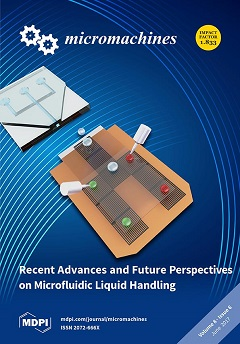Open AccessReview
Microtechnologies for Cell Microenvironment Control and Monitoring
by
Enrique Azuaje-Hualde 1,†, Maite García-Hernando 1,2,†, Jaione Etxebarria-Elezgarai 1,†, Marian M. De Pancorbo 3, Fernando Benito-Lopez 2 and Lourdes Basabe-Desmonts 1,4,*
1
BIOMICs Microfluidics Research Group, Microfluidics Cluster UPV/EHU, Lascaray Research Center, University of the Basque Country UPV/EHU, 01006 Vitoria-Gasteiz, Spain
2
Analytical Microsystems & Materials for Lab-on-a-Chip (AMMa-LOAC) Group, Microfluidics Cluster UPV/EHU, Analytical Chemistry Department, University of the Basque Country UPV/EHU, 01006 Vitoria-Gasteiz, Spain
3
BIOMICs Research Group, Lascaray Research Center, University of the Basque Country UPV/EHU, 01006 Vitoria-Gasteiz, Spain
4
IKERBASQUE, Basque Foundation of Science, 48011 Bilbao, Spain
†
These three authors contributed equally to this work.
Cited by 15 | Viewed by 6348
Abstract
A great breadth of questions remains in cellular biology. Some questions cannot be answered using traditional analytical techniques and so demand the development of new tools for research. In the near future, the development of highly integrated microfluidic analytical platforms will enable the
[...] Read more.
A great breadth of questions remains in cellular biology. Some questions cannot be answered using traditional analytical techniques and so demand the development of new tools for research. In the near future, the development of highly integrated microfluidic analytical platforms will enable the acquisition of unknown biological data. These microfluidic systems must allow cell culture under controlled microenvironment and high throughput analysis. For this purpose, the integration of a variable number of newly developed micro- and nano-technologies, which enable control of topography and surface chemistry, soluble factors, mechanical forces and cell–cell contacts, as well as technology for monitoring cell phenotype and genotype with high spatial and temporal resolution will be necessary. These multifunctional devices must be accompanied by appropriate data analysis and management of the expected large datasets generated. The knowledge gained with these platforms has the potential to improve predictive models of the behavior of cells, impacting directly in better therapies for disease treatment. In this review, we give an overview of the microtechnology toolbox available for the design of high throughput microfluidic platforms for cell analysis. We discuss current microtechnologies for cell microenvironment control, different methodologies to create large arrays of cellular systems and finally techniques for monitoring cells in microfluidic devices.
Full article
►▼
Show Figures






